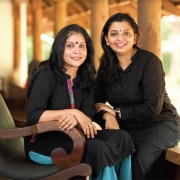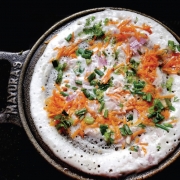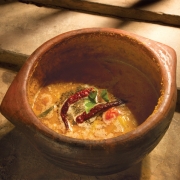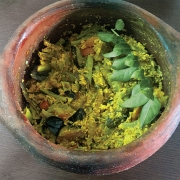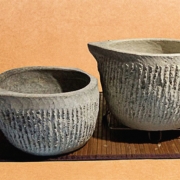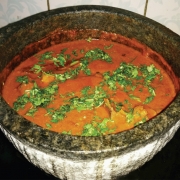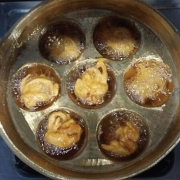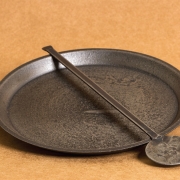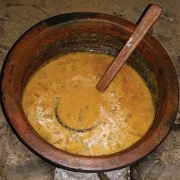
Etcetera
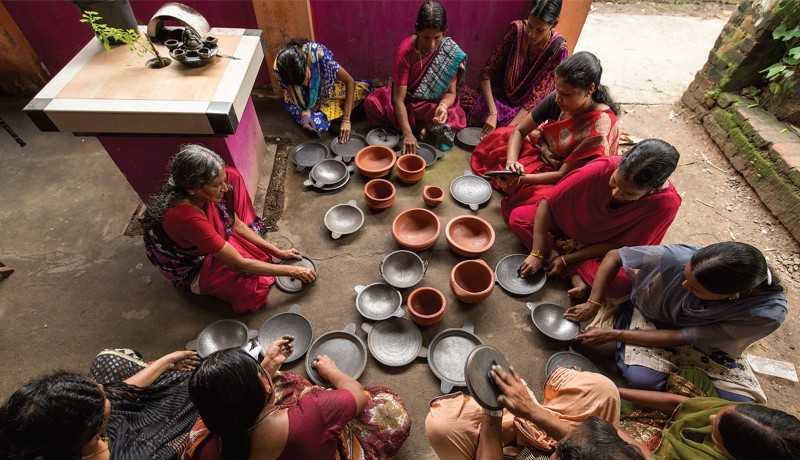
Retaining fragrance, flavour and nutrients, and completely toxin-free and organic, Kochi-based The Village Fair offers traditional cookware that is—quite literally—yours for life, writes Arati Rajan Menon
The best fragrances in life don’t come out of a bottle—the embrace of the first rain by scorched, parched earth; the heady musk of one’s beloved after a day of toil; the dewy-fresh irresistibleness of a newborn; and the deliciousness of crisp, gingelly oil-seasoned dosas with the earthy aroma of onion sambar in mom’s kitchen. Indeed, the very thought of that kitchen, a repository of multiple olfactory and savoury delights, is often a source of bittersweet nostalgia with memories of food, family and myriad flavours merging into a sensory symphony—one that many of us are unable to reproduce in our own homes.
You could blame it on the treadmill of modern life, where culinary traditions are routinely sacrificed at the altar of convenience and speed. And then, there’s the banality of modern cookware, which, at the very least, leeches the flavours and nutrients of most of our food and, at its worst, introduces toxins into our bodies. Little wonder then, that advocates of healthy eating world over are increasingly talking about natural, organic, non-toxic cookware.
In India, this conversation is less about making a switch and more a rediscovery of our culinary DNA in terms of the cast-iron, clay, stone and bronze cookware that took pride of place in the kitchen of yore. And riding the wave of this revival are two women from Kerala—‘dreamer’ Radhika Menon (left) and ‘doer’ Priya Deepak (right)—and their brand, The Village Fair, which aims to ‘bring the ancient wisdom of healthy living to today’s modern world’.
Like so many ventures, this one was born from serendipity. In 2015, when Menon saw a Facebook post recommending the immersion of a cast-iron fish into the cook pot to up the iron quotient, she promptly pulled out her cast-iron cookware—inherited from her grandmother—and posted pictures. The stream of enquiries she received led to something of a Eureka moment. “She called me one morning out of the blue with the idea of traditional cookware as a business venture and said, ‘You have to do this with me’,” recalls Deepak. (The two women, both from a corporate background, had worked together on a project and become friends.) Sceptical at first, Deepak was won over by Menon’s persistence and her own deepening understanding of the benefits and potential of traditional cookware.
For starters, it’s toxin-free, completely organic and healthy. Sturdy as can be, cast-iron cookware requires very little oil and is suffused with rich nutrients, fortifying your food with iron. And clay and stone cookware, ideal for slow cooking your curries with uniform circulation of heat and moisture through the pot, retains all the nutrients while infusing minerals into your food and balancing out its PH levels.
Then, of course, there’s the taste. “When you make a dosa on a cast-iron tawa or chicken curry in a cast-iron kadhai, or a fish curry in a clay chetti, the flavours are unbelievable,” says Deepak. “And there’s nothing quite like a moru [yoghurt-based] curry made in a stone kalchatti. These vessels don’t just retain flavour, they also act as insulators and the food doesn’t spoil. For instance, my fish curry is lying outside for two days in the clay pot. I also believe the flavours of vegetarian food are lost in non-stick cookware. Traditional cookware will make you start loving vegetarian food all over again!”
While The Village Fair sources quality cookware from across Kerala (cast iron from Shornur, clay vessels from Kochi and Palakkad, bronze from Thrissur, and so on), the real value-add comes at the seasoning stage, which is essential before use. They employ about 15 women of all ages (“from mothers-in-law to daughters-in-law and sisters!”) for this intensive and lengthy process, which involves scrubbing the cookware clean, immersing it in rice water over a week to remove the impurities, and then firing it in an oven (in the case of clay vessels) and repeated heating with multiple coatings of vegetable oil (in the case of cast iron). Many of the products, like the dosa tawa, are actually test-driven by the women before they make their way to the customer!
For the women, who are paid ‘per piece’, it is an empowering experience. “They work at their convenience, which has never really clashed with our requirements,” says Deepak. “And now they feel a sense of ownership. In fact, they are a vital part of the quality control process and feel proud at the value they bring to the brand.” What’s more, 5 per cent of all sales go to Kochin-based Mehac Foundation, which works with women with mental health issues as well as their caregivers.
From travelling between the Kochi unit and Bengaluru to hand-deliver orders to customers, the ladies have indeed come a long way in two years. With about 1,000 customers pan India and overseas, The Village Fair is ready to move to the next level with an expansion of its retail and online presence. “This has become a mission for us and we are determined to spread the word,” says Deepak. “This is truly cookware for life—if maintained properly, it only gets better with time and use. And it adds so much value to your body.”
A DAY IN AMMA’S KITCHEN USING THE VILLAGE FAIR’S NATURAL COOKWARE
BREAKFAST
Utthapam
Product: Cast-iron raised edge pan/dosa pan
Ingredients
- Dosa rice: 3 cups
- Urad dal: ¾ cup
- Methi (fenugreek) seeds: 1 tbsp
- Salt to taste
For the topping
- Onion, coriander and green chillies, finely chopped
- Carrot, grated
- Curry leaves: a few
Method
Soak rice, dal and methi seeds in water for at least 6 hours. Grind and keep overnight. In the morning, add salt and a pinch of sugar. Dip half an onion in oil and use it to smear the pan when it is hot. Pour the batter and spread evenly. Wait for a few bubbles to appear; then, add the topping ingredients and press lightly. Flip carefully when you feel it has browned enough. Flip it back and your uthappam is ready! This tastes great with coconut or tomato chutney.
MID-MORNING
Buttermilk
Product: Clay pot/bottle
Ingredients
- Yoghurt: 2 cups
- Cold water: 4 cups
- Ginger: 1 small piece
- Green chillies: 1-2
- Curry leaves: a few
- Salt to taste
Method
Whisk together all ingredients and strain into clay pot or glasses. Store in the fridge or a cool place. Drink a glass mid-morning and beat the heat this summer. The clay pot is also ideal to set your yoghurt.
LUNCH
Palakaddan sambar with coconut
Product: Clay pot/clay kalchatti
While sambar is essentially a Tamilian dish, it has seen local variations across southern India. Growing up, we only knew our grandmother’s version of Palakkad sambar. This is a modified recipe with sambar powder, though she made the sambar mix fresh every time. Also in Palakkadan sambar, we never added any ‘English vegetables’ like carrots, potatoes, beans, etc!
Ingredients
- Tur dal: ½ cup; cooked soft
- Drumsticks, cut into 2-inch pieces
- Large onions, sliced
- Tomatoes, quartered
- Tamarind: juice of 1 lime-sized ball
- Sambar powder: 2 tbsp
- Asafoetida (hing): a pinch, if desired
- Red chilli powder: as desired
- Salt to taste
- Oil, mustard seeds, methi (fenugreek) seeds, dry chillies and curry leaves, for seasoning
To roast and grind
- Coconut: ½ cup
- Shallots: 3-4
- Oil: ½ tsp
- Salt to taste
Method
Roast the ingredients above till coconut gives a fine aroma but is not browned. Grind to a smooth paste. Now, in a clay pot/kalchatti, add all the vegetables except tomatoes to the tur dal with enough water and cook till ¾ done. Add sambar powder, chilli powder, asafoetida and let it cook. Add tamarind juice and tomatoes. Add salt to taste. When done, add the ground coconut paste. Bring it to a boil and remove from fire. Temper ½ tsp mustard seeds, a pinch of methi seeds, 2 dried red chillies and few curry leaves in 1 tbsp of oil and add. Serve with rice.
Avial
Product: Clay kalchatti
Ingredients—all julienned (about 1 inch)
- Ripe cucumber: 150 gm
- Raw banana: 1 small
- Long beans: 100 gm
- Carrot: 1
- Yam: 100 gm
- Drumsticks: 2
- Raw mango: 1
To grind
- Coconut: ½; grated
- Small onions: 2-3
- Green chillies: 2-3
- Cumin seeds: a pinch
For the masala
- Turmeric powder: ¼ tsp
- Chilli powder: 1 tsp
- Salt to taste
To garnish
- Coconut oil
- Curry leaves
Method
Lightly grind the ingredients specified with a few drops of water. Don’t make it a paste. Take the clay kalchatti and add all the vegetables except the raw mango in less than ½ cup of water. Add turmeric, chilli powder and salt as per taste. Boil for about 5 minutes and then add the mango pieces. Let it boil till cooked but don’t over boil. Add the ground coconut masala and cook for 2-3 minutes on a slow flame. Once ready, add few drops of coconut oil and curry leaves.
Kumbalanga mulakooshyam
Product: Stone kalchatti
Anyone from central Kerala will remember the mulakooshyam, usually made from white pumpkin, snake gourd or drumsticks, with nostalgia. When the jackfruit season is on, raw jackfruit is the go-to ingredients.
Ingredients
- White pumpkin: 2 full cups; diced
- Tur dal (or skinned green gram): 1 cup; cooked and mashed
- Turmeric powder: ¼ tsp
- Salt to taste
To grind
- Coconut: ½ cup; scraped
- Green chillies: 4- 6 (depending on how spicy you like it)
- Shallots: 2-4
- Cumin (jeera) seeds: ½ tsp
- Salt to taste
Method
Grind the ingredients specified. In the clay pot, cook the mashed dal and pumpkin with turmeric and enough water till the pumpkin is soft. Add salt to taste. Add the ground coconut and bring to boil; let it simmer for 2-3 minutes and remove from fire. Add a dash of coconut oil and curry leaves or season with spluttered mustard seeds and dry red chillies. Serve with rice and fish fry, if you are a non-vegetarian. And don’t forget the poppadoms!
Mutton rogan josh
Product: Stone kalchatti
Ingredients—to marinate
- Mutton: 1 kg
- Ginger-garlic paste: 2 tbsp
- Coriander powder: 1 tbsp
- Red chilli powder (preferably Kashmiri chilli): 1 tbsp
- Salt to taste
To cook
- Onions: 2 large; thinly sliced
- Ginger-garlic paste: 2 tbsp
- Tomato puree: 1 packet (or blanch 6 tomatoes and puree them)
- Yoghurt: 1 cup
- Cashew paste: 1 cup (fry 100 gm and grind into paste)
- Cumin (jeera) powder: 1 tbsp
- Chilli powder: 1 tbsp
- Garam masala: 1 tbsp
- Oil
- Salt to taste
Whole garam masala (do not grind)
- Peppercorns: 6
- Green cardamoms: 3
- Cloves: 4
- Cinnamon sticks: 2 small
- Bay leaves: 4
- Aniseed (saunf): 1 tsp
Method
Marinate the mutton with all the ingredients and ideally keep overnight; else, for at least an hour. Keep the stone kalchatti on a medium flame with a little oil. When the oil heats, add the whole garam masala.When the spices splutter, add the onion and fry till golden brown. Now, add the ginger-garlic paste and fry till the raw smell reduces. Add the mutton pieces and sauté on high heat for 5 minutes. Reduce heat and add the coriander, chilli and cumin powder. The juices from the meat will now start seeping out. Sauté on medium heat till the water dries up. Now, add the tomato puree and sauté till the oil separates. Add 2 cups of water and cook until the mutton is done. It is recommended to keep it on a reduced flame and cook for an hour or more. When the mutton looks well cooked, whisk in the yoghurt and add the cashew paste. Add the garam masala powder and do not allow it to boil over. Remove from the heat just as it starts to boil and garnish with chopped coriander. Serve it straight out of the stone kalchatti. You will be amazed at how long the vessel retains the heat. This kalchatti can also be used for avial, moru curry, sambar, erashery, olan, stew and masala curry. Some people even use it to store dosa batter in the fridge!
TEATIME
Onion pakoda
Product: Bronze/cast-iron paniyaram pan
Ingredients
- Onions: 2; sliced
- Gram flour (besan): ½ cup
- Rice flour: ¼ cup
- Green chillies: 2; finely chopped
- Red chilli powder: 1 tsp
- Turmeric powder: ¼ tsp
- Asafoetida (hing) powder: 2 pinches
- Coriander leaves: handful; finely chopped
- Curry leaves: handful; finely chopped
- Salt to taste
- Oil to fry
Method
In a mixing bowl, add chopped onions, green chillies, coriander leaves, curry leaves and salt. Mix well with your hand and keep aside for 10 minutes. Meanwhile, heat the oil in the paniyaram pan, with just enough in each compartment to deep fry. Next, add rice flour, gram flour, chilli powder, turmeric and hing powder to the onion mix. Add about 1 tbsp of hot oil to it. Combine well, with just a few drops of water. The lesser the water, the crispier the pakoda. Take small pieces of the pakoda batter and drop into the hot oil in the pan. Turn in between. Keep the flame to medium while dropping the pakoda in and later reduce to low-medium. Deep fry till crisp, in batches, and drain on a kitchen towel. Enjoy the pakoda with mint chutney or ketchup. The pan can also be used to cook traditional dishes like gundponglu/kuzhi paniyaram/paddu, and unniappam. You can even use the pan to bake mini muffins or brownies!
DINNER
Honey glazed chicken
Product: Cast-iron raised edge pan/dosa pan
Ingredients
- Chicken breast: ½ kg
- Honey: 4 tbsp
- Soy sauce: 2 tbsp
- Garlic: 1 tsp; finely chopped
- Ginger: ½ tsp; chopped
- Red chilli powder (preferably Kashmiri) to taste
- Salt and pepper to taste
Method
Smear salt and pepper on the chicken pieces and keep aside for 10 minutes. Heat the pan and pour 1 tsp oil just to glaze it. Place the chicken pieces in the pan and grill in batches till they are light brown on both sides (about 3-4 minutes on both sides). Mix honey, soy sauce, garlic, ginger and a little Kashmiri chilli powder in a cup. Now, put all the chicken pieces back in the pan and pour the honey sauce over it. Keep on a very low flame and let the chicken cook in the sauce for 5-8 minutes or till the sauce thickens. Serve hot with sautéed veggies and garlic bread or stir-fried rice/noodles cooked in a cast-iron kadhai. You can even make a pizza, bake or grill chicken in the oven with a raised-edge pan!
Urulakizhangu nadan masala curry
Product: Stone kalchatti; cast-iron kadhai
Ingredients
- Potatoes: 250 gm; peeled and cubed
- Onions: 2 medium; sliced thin
- Coconut milk: 1 cup
- Ginger: 1 inch; julienned
- Green chillies: 5-6; slit (add more if you like it hot)
- Turmeric: ¼ tsp
- Coconut oil: 1 tsp (can use any vegetable oil)
- Curry leaves: A small bunch
- Salt to taste
To grind
- Coriander (whole): 3 tbsp (can substitute with 2 tbsp powder)
- Red chillies: 3-4
- Cumin (jeera) seeds: ½ tsp
- Peppercorns: 2 tbsp
Method
Lightly roast the masala for grinding with a few drops of oil in the small cast-iron kadhai. Let it cool and grind. Add about 2 cups of water to all the other ingredients and bring to boil in the kalchatti. Add salt. When the onions are done, add the ground masala and let simmer till the masala is cooked well. Add the coconut milk and bring to a gentle boil. Remove from the fire. Add the coconut oil and garnish with curry leaves. Serve hot with rice, chapattis or even dosas!
To learn more about products from The Village Fair, go to thevillagefair.in
Photos courtesy: The Village Fair Featured in Harmony — Celebrate Age Magazine May 2017
you may also like to read
-
Cracking the longevity code
Small yet impactful choices can be game-changers, writes Srirekha Pillai At 102, there’s no stopping Chandigarh-based Man Kaur, the world’s….
-
Home, not alone
While a regulatory framework is vital for senior-care facilities, the need of the hour is to develop an ecosystem to….
-
Birthday Girl
Published in a special edition to honour Japanese master storyteller Haruki Murakami’s 70th birthday, Birthday Girl (Penguin; Rs 100; 42….
-
A huge treat for music lovers
Published as the revised and updated second edition, Incomparable Sachin Dev Burman (Blue Pencil; Rs. 599; 470 pages) the authoritative….



